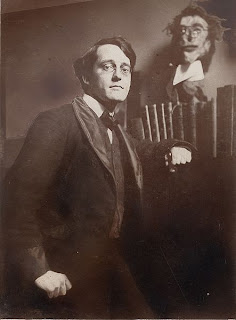| John Sloan, Eagles of Tesuque, oil on canvas, 1921. |
 |
| Portrait of John Sloan (image source). |
The 1968 Acquisition of John Sloan’s “Eagles of Tesuque” was one of the most significant Permanent Collection additions of that year. Sloan was among a revolutionary group of New York artists called The Eight, who sought to establish a truly American art form that would be free of European influences. If The Eight achieved their goal, it was primarily through their depiction of directly observed scenes of everyday American struggle and dignity. The grittiness of the group’s images earned them the name The Ashcan School.
In his late teens, Sloan became responsible for the family’s welfare after his father suffered an incapacitating mental breakdown. Taking up a job at Porter and Coates, a bookstore and fine print vendor, he had the opportunity to look through examples of fine art such as Durer and Rembrandt — inspiring him to take up more creative license in design.
Sloan’s interest in American history and tradition not only found representation through New York-based subject matter, but in Southwestern American scenes as well. Beginning in 1919, Sloan traveled to New Mexico almost annually and depicted scenes such as this, in which two Pueblo Eagle dancers and a chorus perform a ritual to cure illness and promote personal welfare. In keeping with his attraction to a uniquely American dignity, Sloan described Native American rituals such as this as “unimitative” and “profound.”
John Sloan was born Aug. 2, 1871 and died Sept. 7, 1951 in Hanover, N.H.
Eagles of Tesuque is on-view now in the first-floor 75th Anniversary galleries.

